Effective Communication in Business: Models, Methods, and Role Play
VerifiedAdded on 2022/12/27
|15
|4518
|1
Report
AI Summary
This report provides a comprehensive overview of communication skills essential for business, detailing various communication models such as Shannon and Weaver's model and Berlo's SMRC model, alongside communication systems like optical and duplex systems. It explores different communication methods including written, verbal, non-verbal, visual, and electronic, differentiating between formal and informal communication channels and their respective benefits. The report outlines principles of effective communication and identifies common barriers, followed by a role-play scenario demonstrating oral communication skills in addressing an irate customer. Finally, it presents three formal documents as evidence of written communication skills, concluding with a summary of the key concepts discussed.
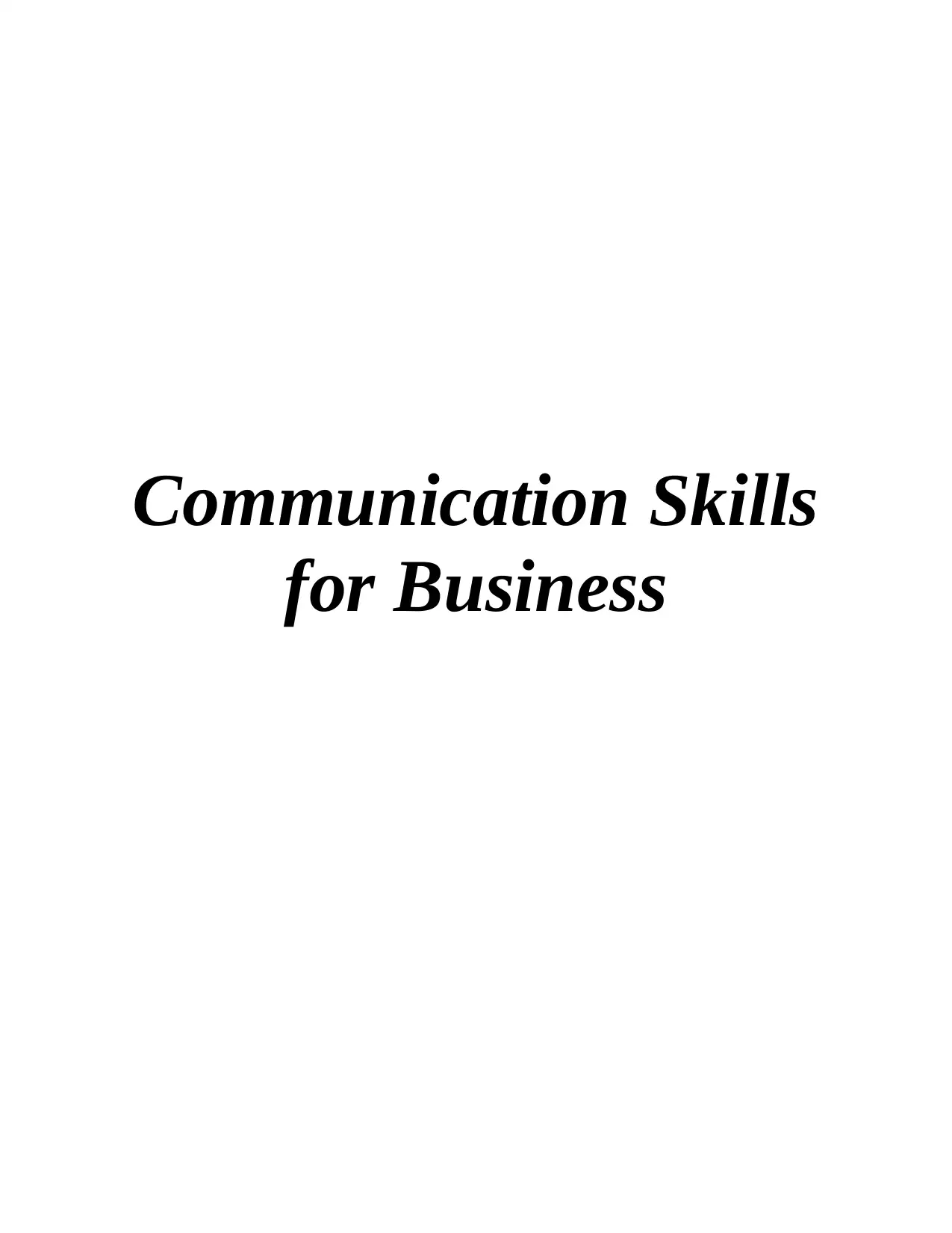
Communication Skills
for Business
for Business
Paraphrase This Document
Need a fresh take? Get an instant paraphrase of this document with our AI Paraphraser
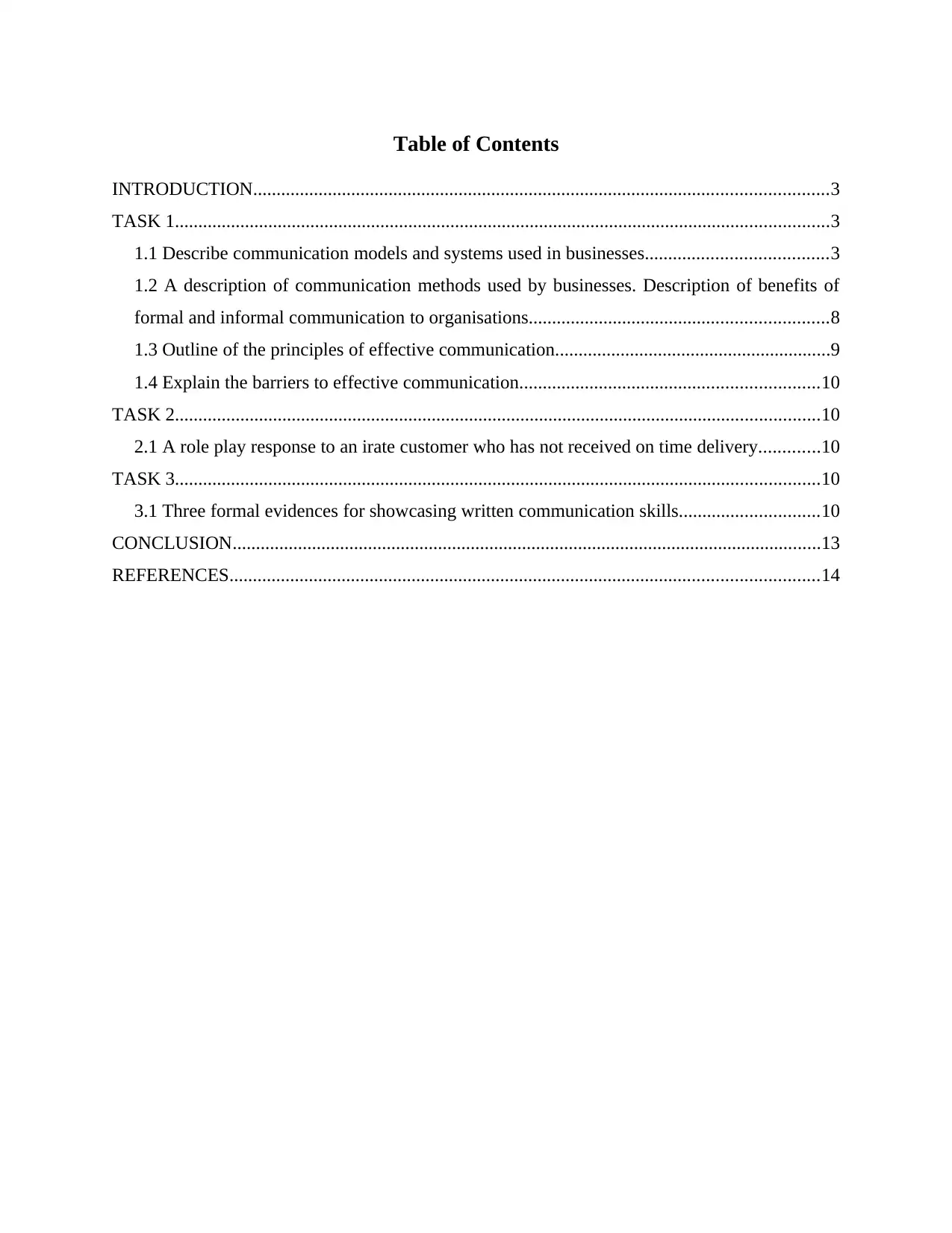
Table of Contents
INTRODUCTION...........................................................................................................................3
TASK 1............................................................................................................................................3
1.1 Describe communication models and systems used in businesses.......................................3
1.2 A description of communication methods used by businesses. Description of benefits of
formal and informal communication to organisations................................................................8
1.3 Outline of the principles of effective communication...........................................................9
1.4 Explain the barriers to effective communication................................................................10
TASK 2..........................................................................................................................................10
2.1 A role play response to an irate customer who has not received on time delivery.............10
TASK 3..........................................................................................................................................10
3.1 Three formal evidences for showcasing written communication skills..............................10
CONCLUSION..............................................................................................................................13
REFERENCES..............................................................................................................................14
INTRODUCTION...........................................................................................................................3
TASK 1............................................................................................................................................3
1.1 Describe communication models and systems used in businesses.......................................3
1.2 A description of communication methods used by businesses. Description of benefits of
formal and informal communication to organisations................................................................8
1.3 Outline of the principles of effective communication...........................................................9
1.4 Explain the barriers to effective communication................................................................10
TASK 2..........................................................................................................................................10
2.1 A role play response to an irate customer who has not received on time delivery.............10
TASK 3..........................................................................................................................................10
3.1 Three formal evidences for showcasing written communication skills..............................10
CONCLUSION..............................................................................................................................13
REFERENCES..............................................................................................................................14
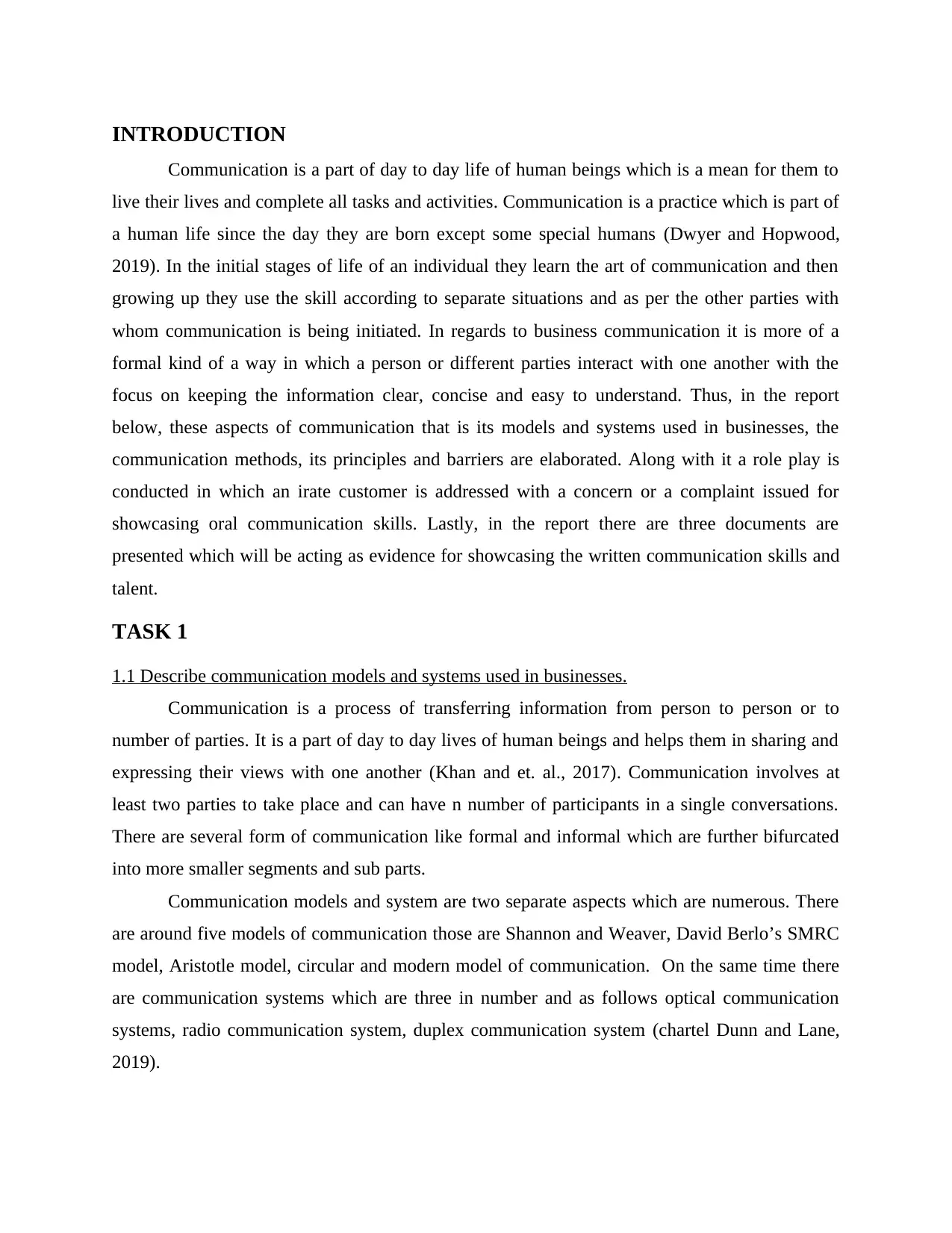
INTRODUCTION
Communication is a part of day to day life of human beings which is a mean for them to
live their lives and complete all tasks and activities. Communication is a practice which is part of
a human life since the day they are born except some special humans (Dwyer and Hopwood,
2019). In the initial stages of life of an individual they learn the art of communication and then
growing up they use the skill according to separate situations and as per the other parties with
whom communication is being initiated. In regards to business communication it is more of a
formal kind of a way in which a person or different parties interact with one another with the
focus on keeping the information clear, concise and easy to understand. Thus, in the report
below, these aspects of communication that is its models and systems used in businesses, the
communication methods, its principles and barriers are elaborated. Along with it a role play is
conducted in which an irate customer is addressed with a concern or a complaint issued for
showcasing oral communication skills. Lastly, in the report there are three documents are
presented which will be acting as evidence for showcasing the written communication skills and
talent.
TASK 1
1.1 Describe communication models and systems used in businesses.
Communication is a process of transferring information from person to person or to
number of parties. It is a part of day to day lives of human beings and helps them in sharing and
expressing their views with one another (Khan and et. al., 2017). Communication involves at
least two parties to take place and can have n number of participants in a single conversations.
There are several form of communication like formal and informal which are further bifurcated
into more smaller segments and sub parts.
Communication models and system are two separate aspects which are numerous. There
are around five models of communication those are Shannon and Weaver, David Berlo’s SMRC
model, Aristotle model, circular and modern model of communication. On the same time there
are communication systems which are three in number and as follows optical communication
systems, radio communication system, duplex communication system (chartel Dunn and Lane,
2019).
Communication is a part of day to day life of human beings which is a mean for them to
live their lives and complete all tasks and activities. Communication is a practice which is part of
a human life since the day they are born except some special humans (Dwyer and Hopwood,
2019). In the initial stages of life of an individual they learn the art of communication and then
growing up they use the skill according to separate situations and as per the other parties with
whom communication is being initiated. In regards to business communication it is more of a
formal kind of a way in which a person or different parties interact with one another with the
focus on keeping the information clear, concise and easy to understand. Thus, in the report
below, these aspects of communication that is its models and systems used in businesses, the
communication methods, its principles and barriers are elaborated. Along with it a role play is
conducted in which an irate customer is addressed with a concern or a complaint issued for
showcasing oral communication skills. Lastly, in the report there are three documents are
presented which will be acting as evidence for showcasing the written communication skills and
talent.
TASK 1
1.1 Describe communication models and systems used in businesses.
Communication is a process of transferring information from person to person or to
number of parties. It is a part of day to day lives of human beings and helps them in sharing and
expressing their views with one another (Khan and et. al., 2017). Communication involves at
least two parties to take place and can have n number of participants in a single conversations.
There are several form of communication like formal and informal which are further bifurcated
into more smaller segments and sub parts.
Communication models and system are two separate aspects which are numerous. There
are around five models of communication those are Shannon and Weaver, David Berlo’s SMRC
model, Aristotle model, circular and modern model of communication. On the same time there
are communication systems which are three in number and as follows optical communication
systems, radio communication system, duplex communication system (chartel Dunn and Lane,
2019).
⊘ This is a preview!⊘
Do you want full access?
Subscribe today to unlock all pages.

Trusted by 1+ million students worldwide
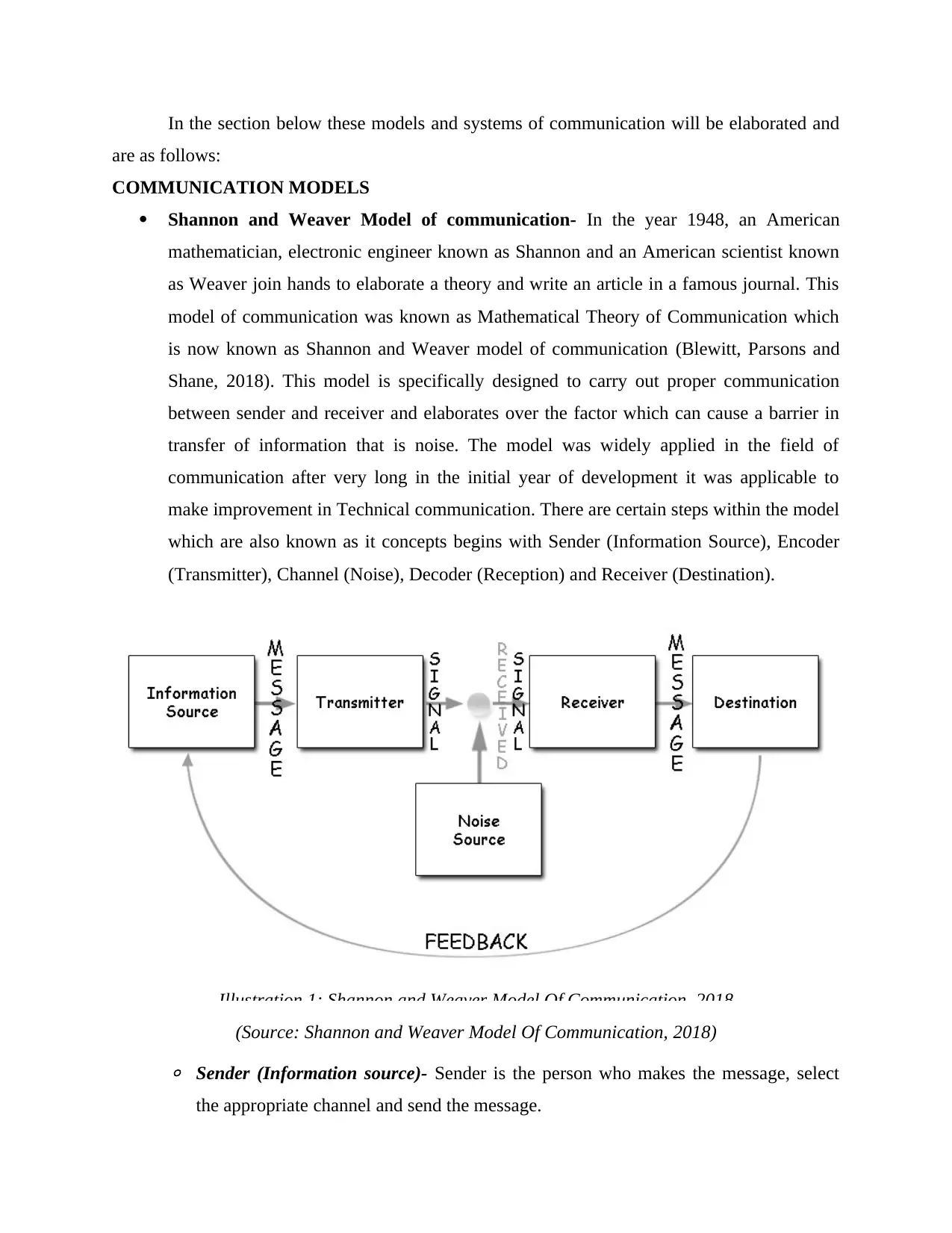
In the section below these models and systems of communication will be elaborated and
are as follows:
COMMUNICATION MODELS
Shannon and Weaver Model of communication- In the year 1948, an American
mathematician, electronic engineer known as Shannon and an American scientist known
as Weaver join hands to elaborate a theory and write an article in a famous journal. This
model of communication was known as Mathematical Theory of Communication which
is now known as Shannon and Weaver model of communication (Blewitt, Parsons and
Shane, 2018). This model is specifically designed to carry out proper communication
between sender and receiver and elaborates over the factor which can cause a barrier in
transfer of information that is noise. The model was widely applied in the field of
communication after very long in the initial year of development it was applicable to
make improvement in Technical communication. There are certain steps within the model
which are also known as it concepts begins with Sender (Information Source), Encoder
(Transmitter), Channel (Noise), Decoder (Reception) and Receiver (Destination).
Illustration 1: Shannon and Weaver Model Of Communication, 2018
(Source: Shannon and Weaver Model Of Communication, 2018)◦ Sender (Information source)- Sender is the person who makes the message, select
the appropriate channel and send the message.
are as follows:
COMMUNICATION MODELS
Shannon and Weaver Model of communication- In the year 1948, an American
mathematician, electronic engineer known as Shannon and an American scientist known
as Weaver join hands to elaborate a theory and write an article in a famous journal. This
model of communication was known as Mathematical Theory of Communication which
is now known as Shannon and Weaver model of communication (Blewitt, Parsons and
Shane, 2018). This model is specifically designed to carry out proper communication
between sender and receiver and elaborates over the factor which can cause a barrier in
transfer of information that is noise. The model was widely applied in the field of
communication after very long in the initial year of development it was applicable to
make improvement in Technical communication. There are certain steps within the model
which are also known as it concepts begins with Sender (Information Source), Encoder
(Transmitter), Channel (Noise), Decoder (Reception) and Receiver (Destination).
Illustration 1: Shannon and Weaver Model Of Communication, 2018
(Source: Shannon and Weaver Model Of Communication, 2018)◦ Sender (Information source)- Sender is the person who makes the message, select
the appropriate channel and send the message.
Paraphrase This Document
Need a fresh take? Get an instant paraphrase of this document with our AI Paraphraser
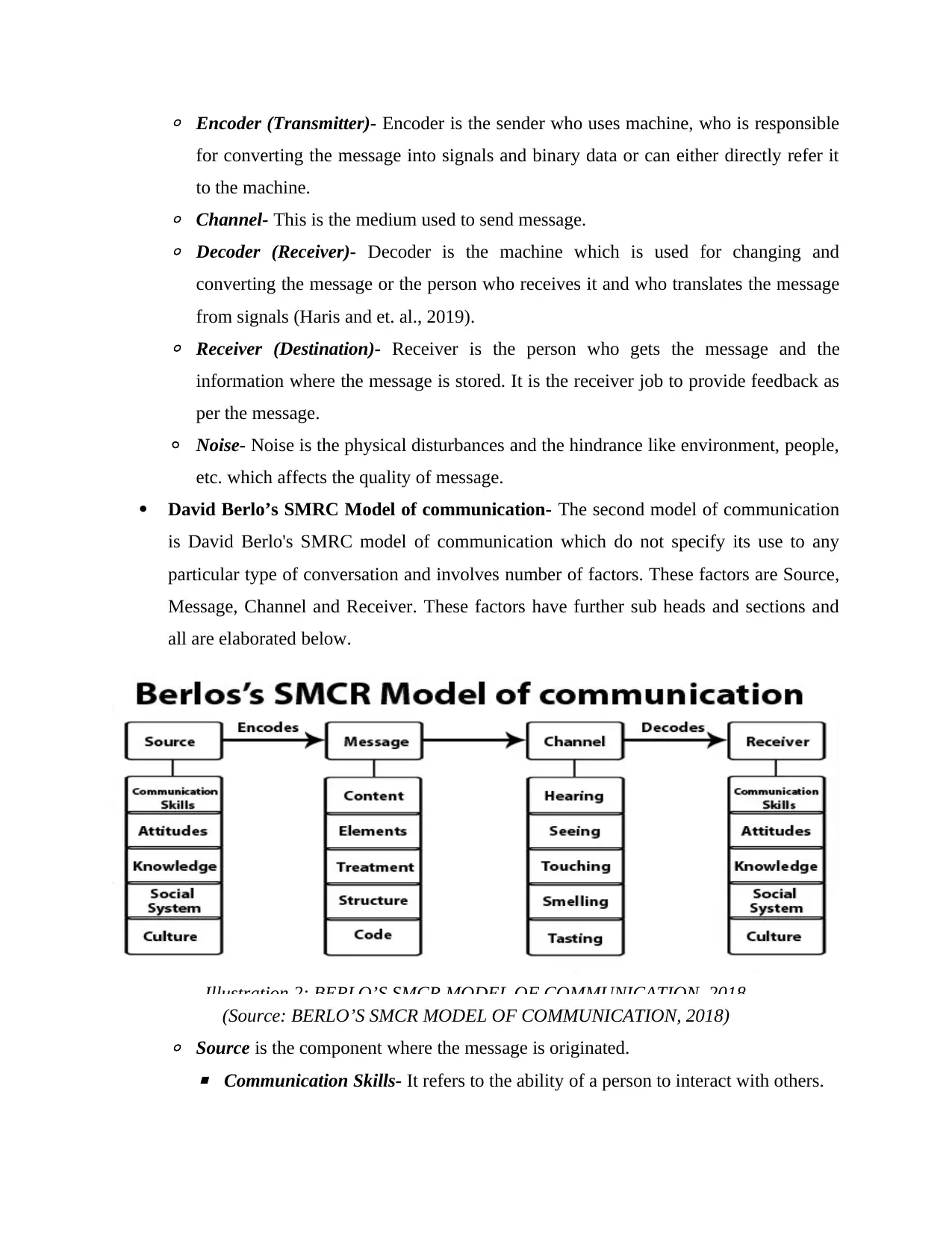
◦ Encoder (Transmitter)- Encoder is the sender who uses machine, who is responsible
for converting the message into signals and binary data or can either directly refer it
to the machine.
◦ Channel- This is the medium used to send message.
◦ Decoder (Receiver)- Decoder is the machine which is used for changing and
converting the message or the person who receives it and who translates the message
from signals (Haris and et. al., 2019).
◦ Receiver (Destination)- Receiver is the person who gets the message and the
information where the message is stored. It is the receiver job to provide feedback as
per the message.
◦ Noise- Noise is the physical disturbances and the hindrance like environment, people,
etc. which affects the quality of message.
David Berlo’s SMRC Model of communication- The second model of communication
is David Berlo's SMRC model of communication which do not specify its use to any
particular type of conversation and involves number of factors. These factors are Source,
Message, Channel and Receiver. These factors have further sub heads and sections and
all are elaborated below.
Illustration 2: BERLO’S SMCR MODEL OF COMMUNICATION, 2018
(Source: BERLO’S SMCR MODEL OF COMMUNICATION, 2018)
◦ Source is the component where the message is originated.
▪ Communication Skills- It refers to the ability of a person to interact with others.
for converting the message into signals and binary data or can either directly refer it
to the machine.
◦ Channel- This is the medium used to send message.
◦ Decoder (Receiver)- Decoder is the machine which is used for changing and
converting the message or the person who receives it and who translates the message
from signals (Haris and et. al., 2019).
◦ Receiver (Destination)- Receiver is the person who gets the message and the
information where the message is stored. It is the receiver job to provide feedback as
per the message.
◦ Noise- Noise is the physical disturbances and the hindrance like environment, people,
etc. which affects the quality of message.
David Berlo’s SMRC Model of communication- The second model of communication
is David Berlo's SMRC model of communication which do not specify its use to any
particular type of conversation and involves number of factors. These factors are Source,
Message, Channel and Receiver. These factors have further sub heads and sections and
all are elaborated below.
Illustration 2: BERLO’S SMCR MODEL OF COMMUNICATION, 2018
(Source: BERLO’S SMCR MODEL OF COMMUNICATION, 2018)
◦ Source is the component where the message is originated.
▪ Communication Skills- It refers to the ability of a person to interact with others.
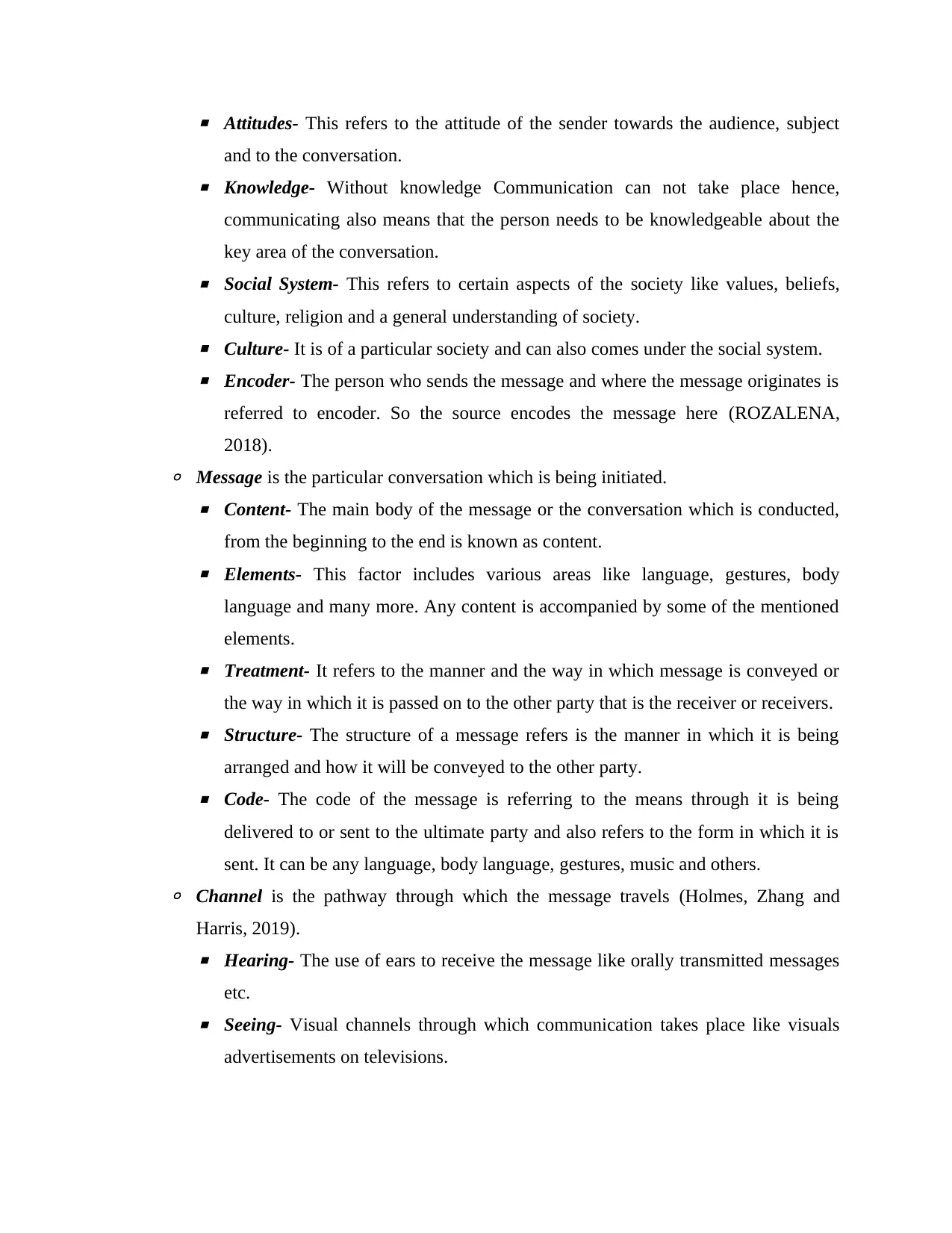
▪ Attitudes- This refers to the attitude of the sender towards the audience, subject
and to the conversation.
▪ Knowledge- Without knowledge Communication can not take place hence,
communicating also means that the person needs to be knowledgeable about the
key area of the conversation.
▪ Social System- This refers to certain aspects of the society like values, beliefs,
culture, religion and a general understanding of society.
▪ Culture- It is of a particular society and can also comes under the social system.
▪ Encoder- The person who sends the message and where the message originates is
referred to encoder. So the source encodes the message here (ROZALENA,
2018).
◦ Message is the particular conversation which is being initiated.
▪ Content- The main body of the message or the conversation which is conducted,
from the beginning to the end is known as content.
▪ Elements- This factor includes various areas like language, gestures, body
language and many more. Any content is accompanied by some of the mentioned
elements.
▪ Treatment- It refers to the manner and the way in which message is conveyed or
the way in which it is passed on to the other party that is the receiver or receivers.
▪ Structure- The structure of a message refers is the manner in which it is being
arranged and how it will be conveyed to the other party.
▪ Code- The code of the message is referring to the means through it is being
delivered to or sent to the ultimate party and also refers to the form in which it is
sent. It can be any language, body language, gestures, music and others.
◦ Channel is the pathway through which the message travels (Holmes, Zhang and
Harris, 2019).
▪ Hearing- The use of ears to receive the message like orally transmitted messages
etc.
▪ Seeing- Visual channels through which communication takes place like visuals
advertisements on televisions.
and to the conversation.
▪ Knowledge- Without knowledge Communication can not take place hence,
communicating also means that the person needs to be knowledgeable about the
key area of the conversation.
▪ Social System- This refers to certain aspects of the society like values, beliefs,
culture, religion and a general understanding of society.
▪ Culture- It is of a particular society and can also comes under the social system.
▪ Encoder- The person who sends the message and where the message originates is
referred to encoder. So the source encodes the message here (ROZALENA,
2018).
◦ Message is the particular conversation which is being initiated.
▪ Content- The main body of the message or the conversation which is conducted,
from the beginning to the end is known as content.
▪ Elements- This factor includes various areas like language, gestures, body
language and many more. Any content is accompanied by some of the mentioned
elements.
▪ Treatment- It refers to the manner and the way in which message is conveyed or
the way in which it is passed on to the other party that is the receiver or receivers.
▪ Structure- The structure of a message refers is the manner in which it is being
arranged and how it will be conveyed to the other party.
▪ Code- The code of the message is referring to the means through it is being
delivered to or sent to the ultimate party and also refers to the form in which it is
sent. It can be any language, body language, gestures, music and others.
◦ Channel is the pathway through which the message travels (Holmes, Zhang and
Harris, 2019).
▪ Hearing- The use of ears to receive the message like orally transmitted messages
etc.
▪ Seeing- Visual channels through which communication takes place like visuals
advertisements on televisions.
⊘ This is a preview!⊘
Do you want full access?
Subscribe today to unlock all pages.

Trusted by 1+ million students worldwide
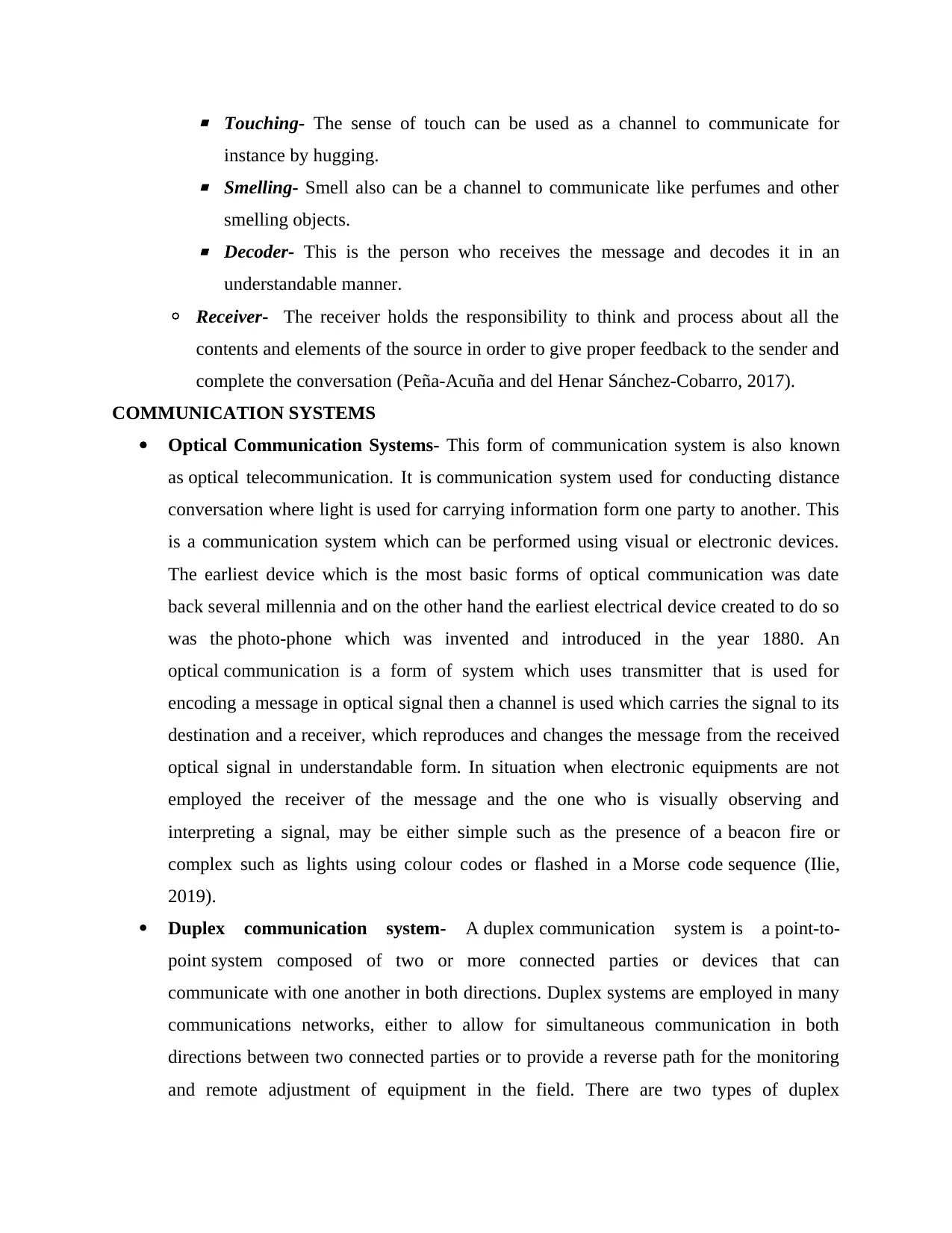
▪ Touching- The sense of touch can be used as a channel to communicate for
instance by hugging.
▪ Smelling- Smell also can be a channel to communicate like perfumes and other
smelling objects.
▪ Decoder- This is the person who receives the message and decodes it in an
understandable manner.
◦ Receiver- The receiver holds the responsibility to think and process about all the
contents and elements of the source in order to give proper feedback to the sender and
complete the conversation (Peña-Acuña and del Henar Sánchez-Cobarro, 2017).
COMMUNICATION SYSTEMS
Optical Communication Systems- This form of communication system is also known
as optical telecommunication. It is communication system used for conducting distance
conversation where light is used for carrying information form one party to another. This
is a communication system which can be performed using visual or electronic devices.
The earliest device which is the most basic forms of optical communication was date
back several millennia and on the other hand the earliest electrical device created to do so
was the photo-phone which was invented and introduced in the year 1880. An
optical communication is a form of system which uses transmitter that is used for
encoding a message in optical signal then a channel is used which carries the signal to its
destination and a receiver, which reproduces and changes the message from the received
optical signal in understandable form. In situation when electronic equipments are not
employed the receiver of the message and the one who is visually observing and
interpreting a signal, may be either simple such as the presence of a beacon fire or
complex such as lights using colour codes or flashed in a Morse code sequence (Ilie,
2019).
Duplex communication system- A duplex communication system is a point-to-
point system composed of two or more connected parties or devices that can
communicate with one another in both directions. Duplex systems are employed in many
communications networks, either to allow for simultaneous communication in both
directions between two connected parties or to provide a reverse path for the monitoring
and remote adjustment of equipment in the field. There are two types of duplex
instance by hugging.
▪ Smelling- Smell also can be a channel to communicate like perfumes and other
smelling objects.
▪ Decoder- This is the person who receives the message and decodes it in an
understandable manner.
◦ Receiver- The receiver holds the responsibility to think and process about all the
contents and elements of the source in order to give proper feedback to the sender and
complete the conversation (Peña-Acuña and del Henar Sánchez-Cobarro, 2017).
COMMUNICATION SYSTEMS
Optical Communication Systems- This form of communication system is also known
as optical telecommunication. It is communication system used for conducting distance
conversation where light is used for carrying information form one party to another. This
is a communication system which can be performed using visual or electronic devices.
The earliest device which is the most basic forms of optical communication was date
back several millennia and on the other hand the earliest electrical device created to do so
was the photo-phone which was invented and introduced in the year 1880. An
optical communication is a form of system which uses transmitter that is used for
encoding a message in optical signal then a channel is used which carries the signal to its
destination and a receiver, which reproduces and changes the message from the received
optical signal in understandable form. In situation when electronic equipments are not
employed the receiver of the message and the one who is visually observing and
interpreting a signal, may be either simple such as the presence of a beacon fire or
complex such as lights using colour codes or flashed in a Morse code sequence (Ilie,
2019).
Duplex communication system- A duplex communication system is a point-to-
point system composed of two or more connected parties or devices that can
communicate with one another in both directions. Duplex systems are employed in many
communications networks, either to allow for simultaneous communication in both
directions between two connected parties or to provide a reverse path for the monitoring
and remote adjustment of equipment in the field. There are two types of duplex
Paraphrase This Document
Need a fresh take? Get an instant paraphrase of this document with our AI Paraphraser
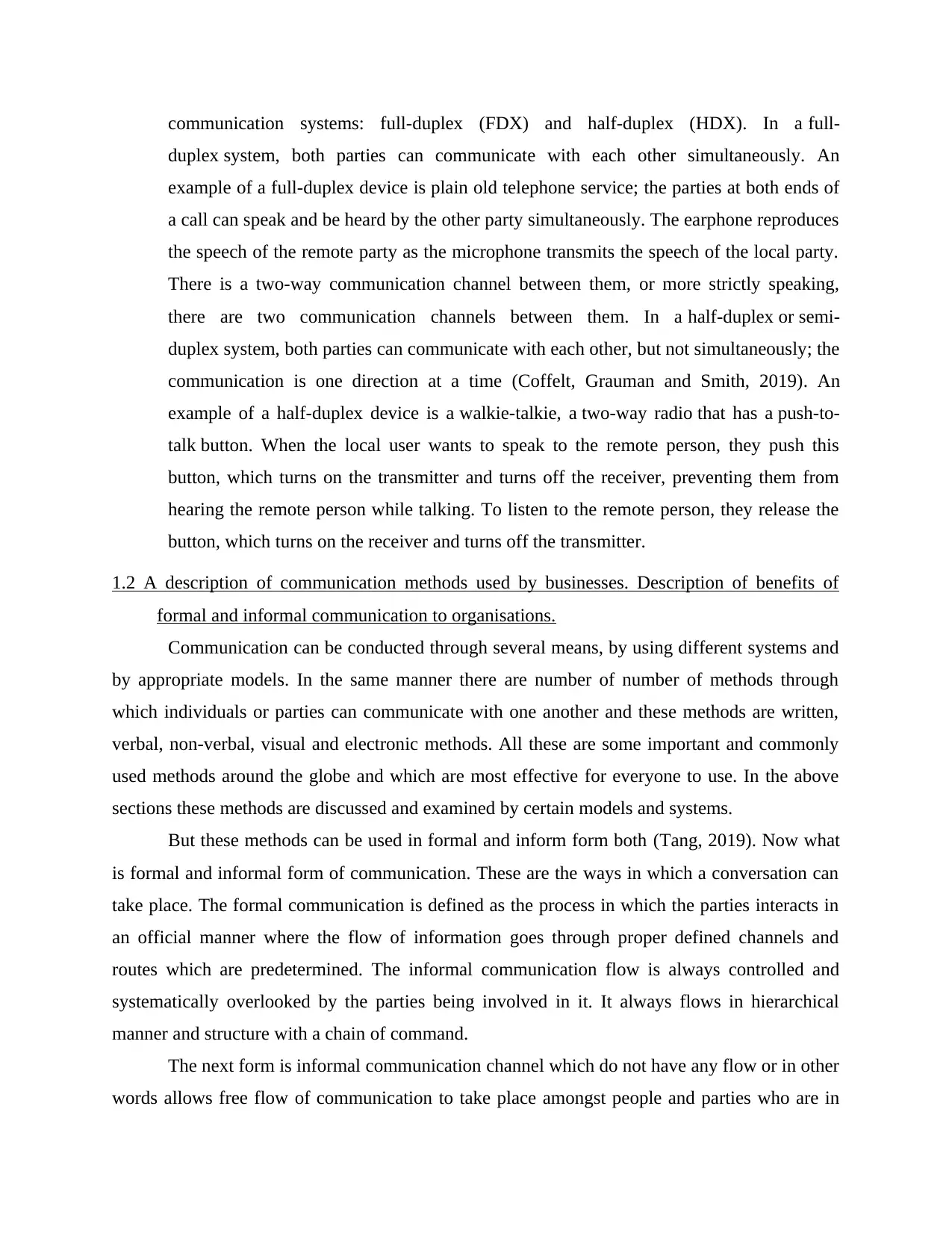
communication systems: full-duplex (FDX) and half-duplex (HDX). In a full-
duplex system, both parties can communicate with each other simultaneously. An
example of a full-duplex device is plain old telephone service; the parties at both ends of
a call can speak and be heard by the other party simultaneously. The earphone reproduces
the speech of the remote party as the microphone transmits the speech of the local party.
There is a two-way communication channel between them, or more strictly speaking,
there are two communication channels between them. In a half-duplex or semi-
duplex system, both parties can communicate with each other, but not simultaneously; the
communication is one direction at a time (Coffelt, Grauman and Smith, 2019). An
example of a half-duplex device is a walkie-talkie, a two-way radio that has a push-to-
talk button. When the local user wants to speak to the remote person, they push this
button, which turns on the transmitter and turns off the receiver, preventing them from
hearing the remote person while talking. To listen to the remote person, they release the
button, which turns on the receiver and turns off the transmitter.
1.2 A description of communication methods used by businesses. Description of benefits of
formal and informal communication to organisations.
Communication can be conducted through several means, by using different systems and
by appropriate models. In the same manner there are number of number of methods through
which individuals or parties can communicate with one another and these methods are written,
verbal, non-verbal, visual and electronic methods. All these are some important and commonly
used methods around the globe and which are most effective for everyone to use. In the above
sections these methods are discussed and examined by certain models and systems.
But these methods can be used in formal and inform form both (Tang, 2019). Now what
is formal and informal form of communication. These are the ways in which a conversation can
take place. The formal communication is defined as the process in which the parties interacts in
an official manner where the flow of information goes through proper defined channels and
routes which are predetermined. The informal communication flow is always controlled and
systematically overlooked by the parties being involved in it. It always flows in hierarchical
manner and structure with a chain of command.
The next form is informal communication channel which do not have any flow or in other
words allows free flow of communication to take place amongst people and parties who are in
duplex system, both parties can communicate with each other simultaneously. An
example of a full-duplex device is plain old telephone service; the parties at both ends of
a call can speak and be heard by the other party simultaneously. The earphone reproduces
the speech of the remote party as the microphone transmits the speech of the local party.
There is a two-way communication channel between them, or more strictly speaking,
there are two communication channels between them. In a half-duplex or semi-
duplex system, both parties can communicate with each other, but not simultaneously; the
communication is one direction at a time (Coffelt, Grauman and Smith, 2019). An
example of a half-duplex device is a walkie-talkie, a two-way radio that has a push-to-
talk button. When the local user wants to speak to the remote person, they push this
button, which turns on the transmitter and turns off the receiver, preventing them from
hearing the remote person while talking. To listen to the remote person, they release the
button, which turns on the receiver and turns off the transmitter.
1.2 A description of communication methods used by businesses. Description of benefits of
formal and informal communication to organisations.
Communication can be conducted through several means, by using different systems and
by appropriate models. In the same manner there are number of number of methods through
which individuals or parties can communicate with one another and these methods are written,
verbal, non-verbal, visual and electronic methods. All these are some important and commonly
used methods around the globe and which are most effective for everyone to use. In the above
sections these methods are discussed and examined by certain models and systems.
But these methods can be used in formal and inform form both (Tang, 2019). Now what
is formal and informal form of communication. These are the ways in which a conversation can
take place. The formal communication is defined as the process in which the parties interacts in
an official manner where the flow of information goes through proper defined channels and
routes which are predetermined. The informal communication flow is always controlled and
systematically overlooked by the parties being involved in it. It always flows in hierarchical
manner and structure with a chain of command.
The next form is informal communication channel which do not have any flow or in other
words allows free flow of communication to take place amongst people and parties who are in
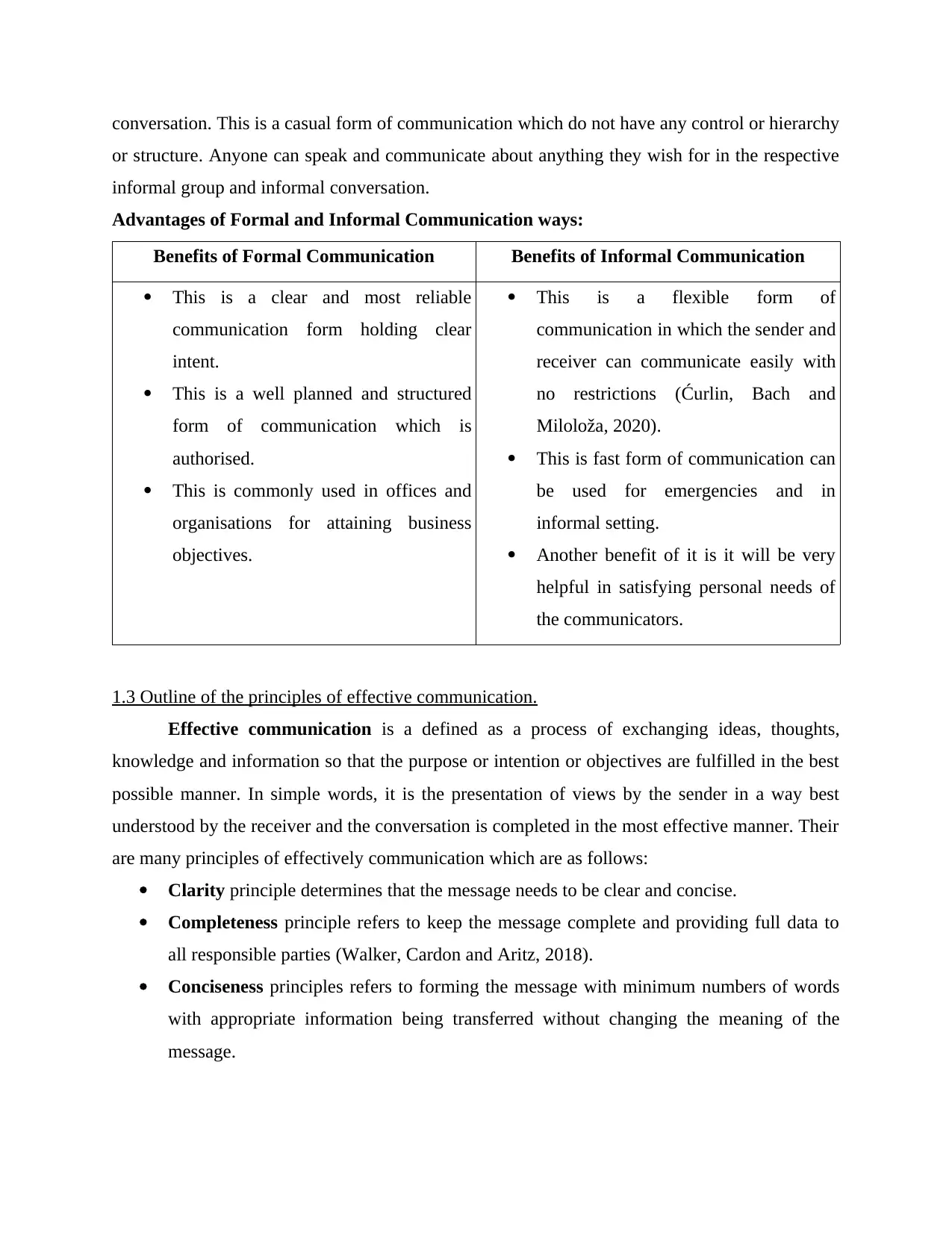
conversation. This is a casual form of communication which do not have any control or hierarchy
or structure. Anyone can speak and communicate about anything they wish for in the respective
informal group and informal conversation.
Advantages of Formal and Informal Communication ways:
Benefits of Formal Communication Benefits of Informal Communication
This is a clear and most reliable
communication form holding clear
intent.
This is a well planned and structured
form of communication which is
authorised.
This is commonly used in offices and
organisations for attaining business
objectives.
This is a flexible form of
communication in which the sender and
receiver can communicate easily with
no restrictions (Ćurlin, Bach and
Miloloža, 2020).
This is fast form of communication can
be used for emergencies and in
informal setting.
Another benefit of it is it will be very
helpful in satisfying personal needs of
the communicators.
1.3 Outline of the principles of effective communication.
Effective communication is a defined as a process of exchanging ideas, thoughts,
knowledge and information so that the purpose or intention or objectives are fulfilled in the best
possible manner. In simple words, it is the presentation of views by the sender in a way best
understood by the receiver and the conversation is completed in the most effective manner. Their
are many principles of effectively communication which are as follows:
Clarity principle determines that the message needs to be clear and concise.
Completeness principle refers to keep the message complete and providing full data to
all responsible parties (Walker, Cardon and Aritz, 2018).
Conciseness principles refers to forming the message with minimum numbers of words
with appropriate information being transferred without changing the meaning of the
message.
or structure. Anyone can speak and communicate about anything they wish for in the respective
informal group and informal conversation.
Advantages of Formal and Informal Communication ways:
Benefits of Formal Communication Benefits of Informal Communication
This is a clear and most reliable
communication form holding clear
intent.
This is a well planned and structured
form of communication which is
authorised.
This is commonly used in offices and
organisations for attaining business
objectives.
This is a flexible form of
communication in which the sender and
receiver can communicate easily with
no restrictions (Ćurlin, Bach and
Miloloža, 2020).
This is fast form of communication can
be used for emergencies and in
informal setting.
Another benefit of it is it will be very
helpful in satisfying personal needs of
the communicators.
1.3 Outline of the principles of effective communication.
Effective communication is a defined as a process of exchanging ideas, thoughts,
knowledge and information so that the purpose or intention or objectives are fulfilled in the best
possible manner. In simple words, it is the presentation of views by the sender in a way best
understood by the receiver and the conversation is completed in the most effective manner. Their
are many principles of effectively communication which are as follows:
Clarity principle determines that the message needs to be clear and concise.
Completeness principle refers to keep the message complete and providing full data to
all responsible parties (Walker, Cardon and Aritz, 2018).
Conciseness principles refers to forming the message with minimum numbers of words
with appropriate information being transferred without changing the meaning of the
message.
⊘ This is a preview!⊘
Do you want full access?
Subscribe today to unlock all pages.

Trusted by 1+ million students worldwide
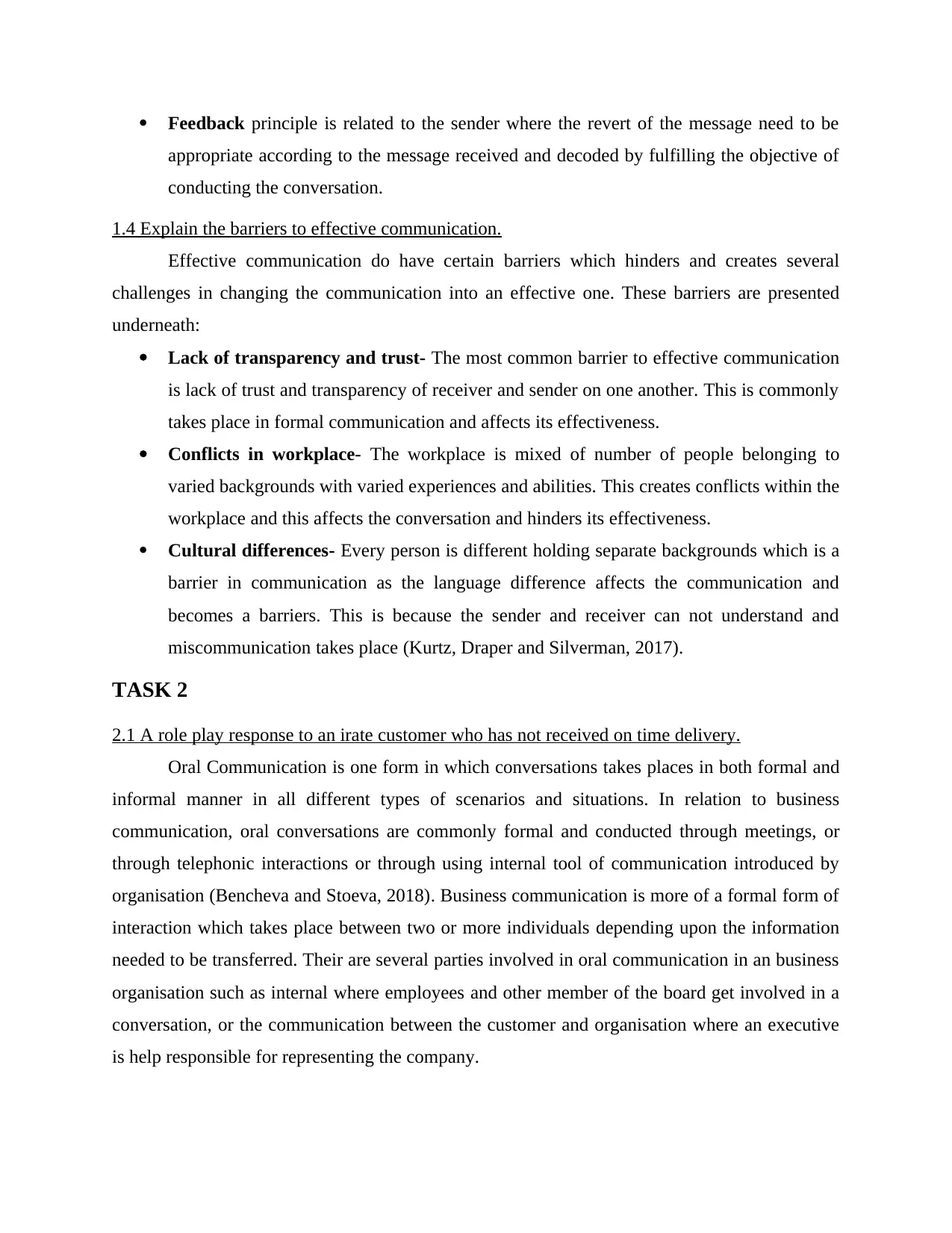
Feedback principle is related to the sender where the revert of the message need to be
appropriate according to the message received and decoded by fulfilling the objective of
conducting the conversation.
1.4 Explain the barriers to effective communication.
Effective communication do have certain barriers which hinders and creates several
challenges in changing the communication into an effective one. These barriers are presented
underneath:
Lack of transparency and trust- The most common barrier to effective communication
is lack of trust and transparency of receiver and sender on one another. This is commonly
takes place in formal communication and affects its effectiveness.
Conflicts in workplace- The workplace is mixed of number of people belonging to
varied backgrounds with varied experiences and abilities. This creates conflicts within the
workplace and this affects the conversation and hinders its effectiveness.
Cultural differences- Every person is different holding separate backgrounds which is a
barrier in communication as the language difference affects the communication and
becomes a barriers. This is because the sender and receiver can not understand and
miscommunication takes place (Kurtz, Draper and Silverman, 2017).
TASK 2
2.1 A role play response to an irate customer who has not received on time delivery.
Oral Communication is one form in which conversations takes places in both formal and
informal manner in all different types of scenarios and situations. In relation to business
communication, oral conversations are commonly formal and conducted through meetings, or
through telephonic interactions or through using internal tool of communication introduced by
organisation (Bencheva and Stoeva, 2018). Business communication is more of a formal form of
interaction which takes place between two or more individuals depending upon the information
needed to be transferred. Their are several parties involved in oral communication in an business
organisation such as internal where employees and other member of the board get involved in a
conversation, or the communication between the customer and organisation where an executive
is help responsible for representing the company.
appropriate according to the message received and decoded by fulfilling the objective of
conducting the conversation.
1.4 Explain the barriers to effective communication.
Effective communication do have certain barriers which hinders and creates several
challenges in changing the communication into an effective one. These barriers are presented
underneath:
Lack of transparency and trust- The most common barrier to effective communication
is lack of trust and transparency of receiver and sender on one another. This is commonly
takes place in formal communication and affects its effectiveness.
Conflicts in workplace- The workplace is mixed of number of people belonging to
varied backgrounds with varied experiences and abilities. This creates conflicts within the
workplace and this affects the conversation and hinders its effectiveness.
Cultural differences- Every person is different holding separate backgrounds which is a
barrier in communication as the language difference affects the communication and
becomes a barriers. This is because the sender and receiver can not understand and
miscommunication takes place (Kurtz, Draper and Silverman, 2017).
TASK 2
2.1 A role play response to an irate customer who has not received on time delivery.
Oral Communication is one form in which conversations takes places in both formal and
informal manner in all different types of scenarios and situations. In relation to business
communication, oral conversations are commonly formal and conducted through meetings, or
through telephonic interactions or through using internal tool of communication introduced by
organisation (Bencheva and Stoeva, 2018). Business communication is more of a formal form of
interaction which takes place between two or more individuals depending upon the information
needed to be transferred. Their are several parties involved in oral communication in an business
organisation such as internal where employees and other member of the board get involved in a
conversation, or the communication between the customer and organisation where an executive
is help responsible for representing the company.
Paraphrase This Document
Need a fresh take? Get an instant paraphrase of this document with our AI Paraphraser
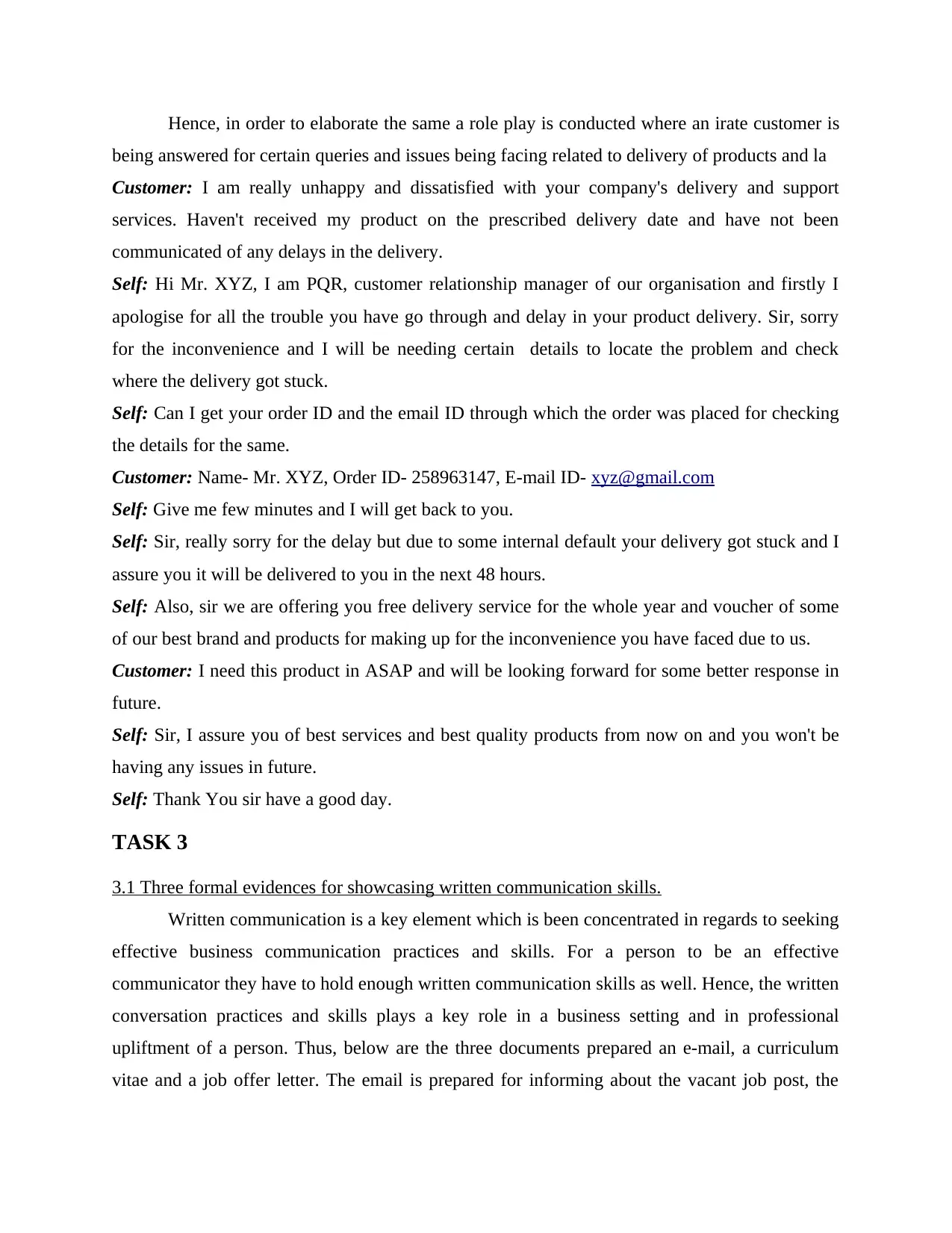
Hence, in order to elaborate the same a role play is conducted where an irate customer is
being answered for certain queries and issues being facing related to delivery of products and la
Customer: I am really unhappy and dissatisfied with your company's delivery and support
services. Haven't received my product on the prescribed delivery date and have not been
communicated of any delays in the delivery.
Self: Hi Mr. XYZ, I am PQR, customer relationship manager of our organisation and firstly I
apologise for all the trouble you have go through and delay in your product delivery. Sir, sorry
for the inconvenience and I will be needing certain details to locate the problem and check
where the delivery got stuck.
Self: Can I get your order ID and the email ID through which the order was placed for checking
the details for the same.
Customer: Name- Mr. XYZ, Order ID- 258963147, E-mail ID- xyz@gmail.com
Self: Give me few minutes and I will get back to you.
Self: Sir, really sorry for the delay but due to some internal default your delivery got stuck and I
assure you it will be delivered to you in the next 48 hours.
Self: Also, sir we are offering you free delivery service for the whole year and voucher of some
of our best brand and products for making up for the inconvenience you have faced due to us.
Customer: I need this product in ASAP and will be looking forward for some better response in
future.
Self: Sir, I assure you of best services and best quality products from now on and you won't be
having any issues in future.
Self: Thank You sir have a good day.
TASK 3
3.1 Three formal evidences for showcasing written communication skills.
Written communication is a key element which is been concentrated in regards to seeking
effective business communication practices and skills. For a person to be an effective
communicator they have to hold enough written communication skills as well. Hence, the written
conversation practices and skills plays a key role in a business setting and in professional
upliftment of a person. Thus, below are the three documents prepared an e-mail, a curriculum
vitae and a job offer letter. The email is prepared for informing about the vacant job post, the
being answered for certain queries and issues being facing related to delivery of products and la
Customer: I am really unhappy and dissatisfied with your company's delivery and support
services. Haven't received my product on the prescribed delivery date and have not been
communicated of any delays in the delivery.
Self: Hi Mr. XYZ, I am PQR, customer relationship manager of our organisation and firstly I
apologise for all the trouble you have go through and delay in your product delivery. Sir, sorry
for the inconvenience and I will be needing certain details to locate the problem and check
where the delivery got stuck.
Self: Can I get your order ID and the email ID through which the order was placed for checking
the details for the same.
Customer: Name- Mr. XYZ, Order ID- 258963147, E-mail ID- xyz@gmail.com
Self: Give me few minutes and I will get back to you.
Self: Sir, really sorry for the delay but due to some internal default your delivery got stuck and I
assure you it will be delivered to you in the next 48 hours.
Self: Also, sir we are offering you free delivery service for the whole year and voucher of some
of our best brand and products for making up for the inconvenience you have faced due to us.
Customer: I need this product in ASAP and will be looking forward for some better response in
future.
Self: Sir, I assure you of best services and best quality products from now on and you won't be
having any issues in future.
Self: Thank You sir have a good day.
TASK 3
3.1 Three formal evidences for showcasing written communication skills.
Written communication is a key element which is been concentrated in regards to seeking
effective business communication practices and skills. For a person to be an effective
communicator they have to hold enough written communication skills as well. Hence, the written
conversation practices and skills plays a key role in a business setting and in professional
upliftment of a person. Thus, below are the three documents prepared an e-mail, a curriculum
vitae and a job offer letter. The email is prepared for informing about the vacant job post, the
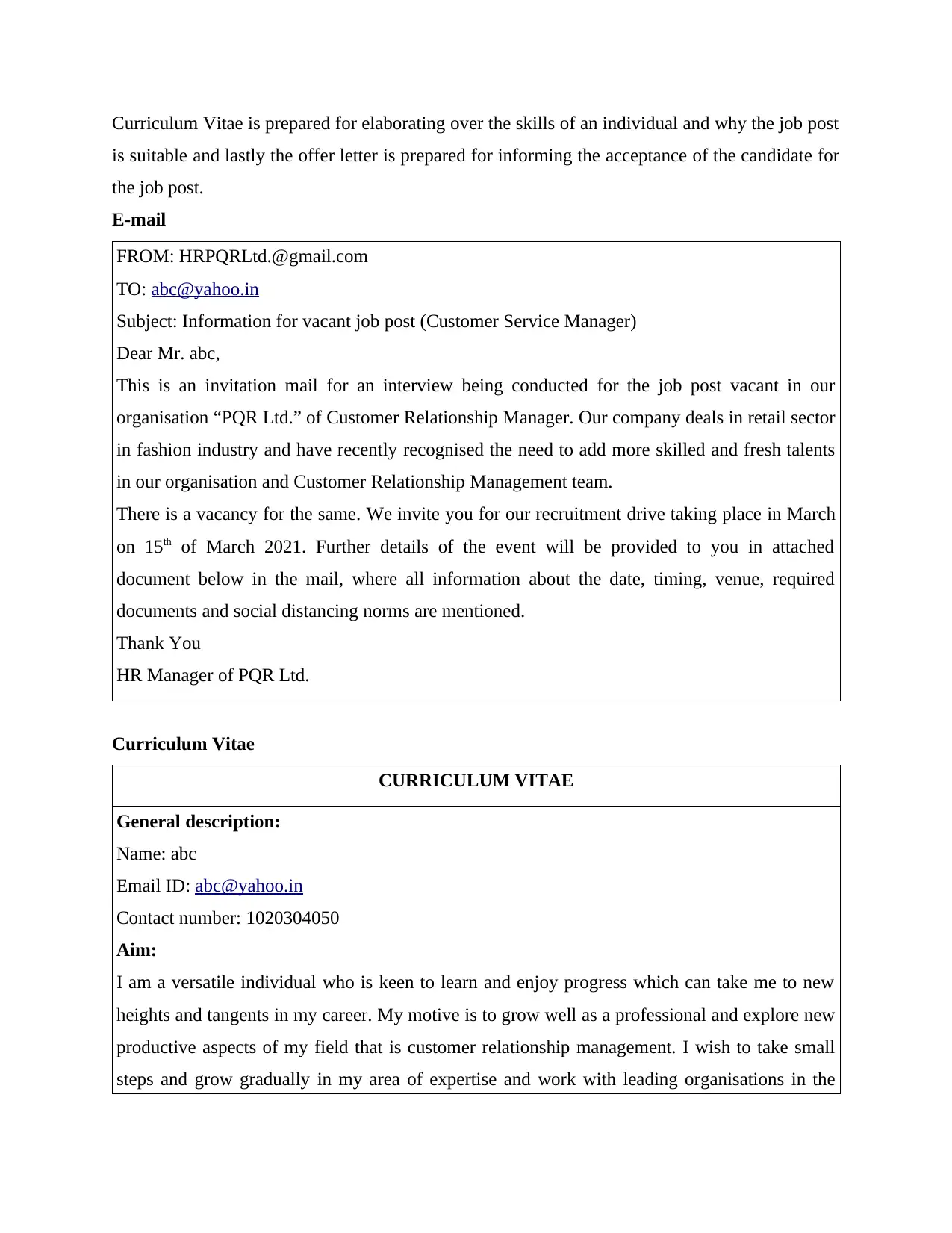
Curriculum Vitae is prepared for elaborating over the skills of an individual and why the job post
is suitable and lastly the offer letter is prepared for informing the acceptance of the candidate for
the job post.
E-mail
FROM: HRPQRLtd.@gmail.com
TO: abc@yahoo.in
Subject: Information for vacant job post (Customer Service Manager)
Dear Mr. abc,
This is an invitation mail for an interview being conducted for the job post vacant in our
organisation “PQR Ltd.” of Customer Relationship Manager. Our company deals in retail sector
in fashion industry and have recently recognised the need to add more skilled and fresh talents
in our organisation and Customer Relationship Management team.
There is a vacancy for the same. We invite you for our recruitment drive taking place in March
on 15th of March 2021. Further details of the event will be provided to you in attached
document below in the mail, where all information about the date, timing, venue, required
documents and social distancing norms are mentioned.
Thank You
HR Manager of PQR Ltd.
Curriculum Vitae
CURRICULUM VITAE
General description:
Name: abc
Email ID: abc@yahoo.in
Contact number: 1020304050
Aim:
I am a versatile individual who is keen to learn and enjoy progress which can take me to new
heights and tangents in my career. My motive is to grow well as a professional and explore new
productive aspects of my field that is customer relationship management. I wish to take small
steps and grow gradually in my area of expertise and work with leading organisations in the
is suitable and lastly the offer letter is prepared for informing the acceptance of the candidate for
the job post.
FROM: HRPQRLtd.@gmail.com
TO: abc@yahoo.in
Subject: Information for vacant job post (Customer Service Manager)
Dear Mr. abc,
This is an invitation mail for an interview being conducted for the job post vacant in our
organisation “PQR Ltd.” of Customer Relationship Manager. Our company deals in retail sector
in fashion industry and have recently recognised the need to add more skilled and fresh talents
in our organisation and Customer Relationship Management team.
There is a vacancy for the same. We invite you for our recruitment drive taking place in March
on 15th of March 2021. Further details of the event will be provided to you in attached
document below in the mail, where all information about the date, timing, venue, required
documents and social distancing norms are mentioned.
Thank You
HR Manager of PQR Ltd.
Curriculum Vitae
CURRICULUM VITAE
General description:
Name: abc
Email ID: abc@yahoo.in
Contact number: 1020304050
Aim:
I am a versatile individual who is keen to learn and enjoy progress which can take me to new
heights and tangents in my career. My motive is to grow well as a professional and explore new
productive aspects of my field that is customer relationship management. I wish to take small
steps and grow gradually in my area of expertise and work with leading organisations in the
⊘ This is a preview!⊘
Do you want full access?
Subscribe today to unlock all pages.

Trusted by 1+ million students worldwide
1 out of 15
Related Documents
Your All-in-One AI-Powered Toolkit for Academic Success.
+13062052269
info@desklib.com
Available 24*7 on WhatsApp / Email
![[object Object]](/_next/static/media/star-bottom.7253800d.svg)
Unlock your academic potential
Copyright © 2020–2025 A2Z Services. All Rights Reserved. Developed and managed by ZUCOL.





